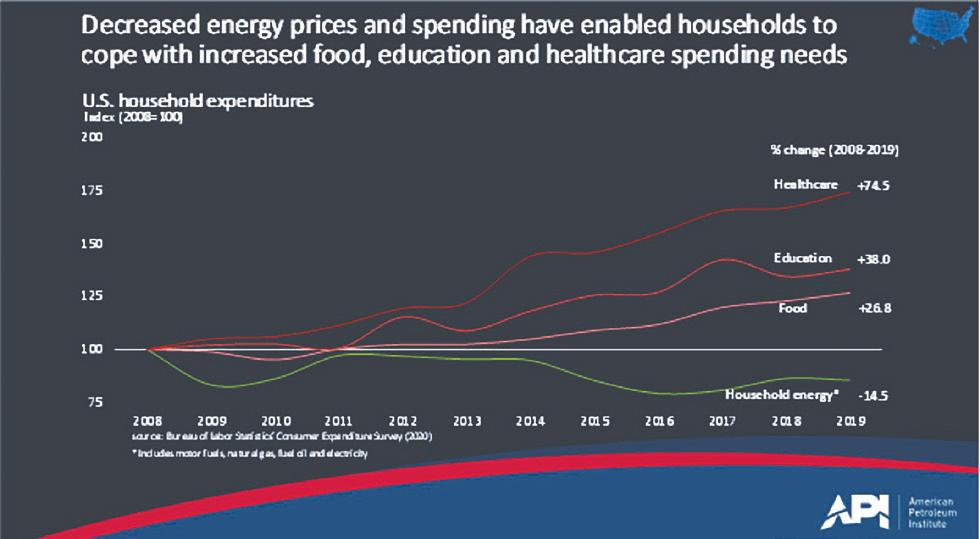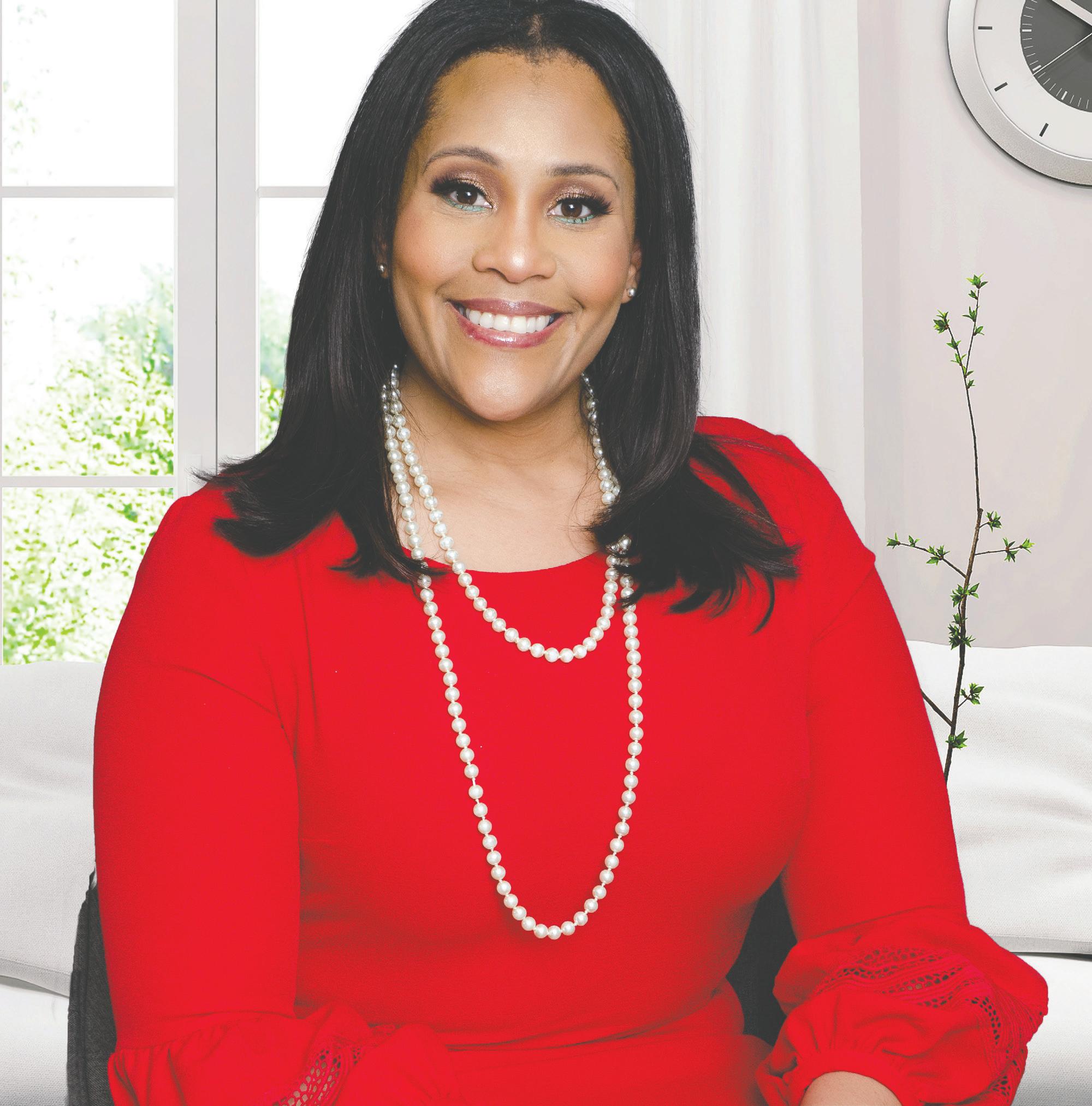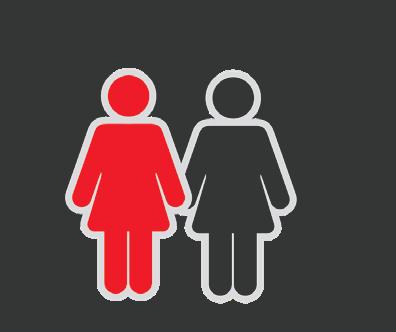





Most people are concerned when energy costs rise, especially prices at the pump. It’s understandable since the average household spent nearly $4,100 on energy in 2019, per the U.S. Bureau of Labor Statistics’ (BLS) Consumer Expenditure Survey.
For more than a decade, expanded U.S. energy production helped lower energy costs, giving consumers more disposable income to afford other essentials like food, education and healthcare, which rose by 27% , 38% and 75% , respectively, according to the Bureau of Labor Statistics (BLS).
However, with U.S. natural gas and oil production down recently, energy costs have been on the rise. The price of crude oil, historically the biggest factor in the cost of gasoline, has risen nearly 30% year over year (y/y), and consequently gasoline prices were up 14% y/y as of March 8, according to the U.S. Energy Information Administration (EIA). Electricity and natural gas bills also have increased faster than overall consumer price inflation so far in 2021.
Further energy cost increases could result from the Biden administration’s decision to halt new federal natural gas and oil leasing, potentially reducing domestic production, as well as other possible actions that could limit drilling or hydraulic fracturing. These could put upward pressure on energy costs that then could ripple across the broader economy.
Yet, energy policy choices could affect far more than just what you pay for a gallon of gasoline or your monthly electricity bill.
For example, imagine trying to make ends meet if U.S. energy policies raised the costs of housing and vehicles, in addition to the energy they require. Housing, vehicles and energy represent more than half of a typical household’s expenditures. While spending on energy since 2009 fell 10% to 15% across every income bracket, Americans’ nonenergy spending on housing, vehicles, maintenance and insurance rose the fastest among those who could least afford increases. Real housing expenditures (excluding energy) by the lowest 40% of U.S. households by income increased about 10% between 2009 and 2019 – roughly three times the rate among wealthy households. Over the same period, real household spending on vehicles, insurance and public transit rose 35% among the lowest 20% of households by income, more than twice the rate of wealthier households.

These concerns loom over an economy where vehicles and housing have recently become even more expensive for some.
Now consider the potential costs of electric vehicles and charging infrastructure, which the administration is signaling it wants the nation to transition
to and build; the ratcheting up of fuel economy standards, which the auto industry suggested in January would cost more than $1 billion annually; plus incentives and/or state requirements like California’s which mandate residential solar panels on new construction, estimated to add $8,400 to the cost of a single-family home. Each of these would add up-front costs that disproportionately impact the 60% of U.S. households earning $53,123 or less in 2019, per BLS.
To be clear, the industry supports higher energy efficiency where it is cost effective. However, policies that undermine domestic energy production and blanket regulations that favor certain technologies over others for vehicles or homes could harm consumers.
Higher costs for housing, vehicles and energy could ultimately require making sacrifices in the American way of life. Energy policies that could raise these costs should be discussed clearly and in the context of what is affordable to American households.
Dr. R. Dean Foreman is API’s chief economist and an expert in the economics and markets for oil, natural gas and power with more than two decades of industry experience including ExxonMobil, Talisman Energy, Sasol, and Saudi Aramco in forecasting & market analysis, corporate strategic planning, and finance/risk management. He is known for knowledge of energy markets, applying advanced analytics to assess risk in these markets, and clearly and effectively communicating with management, policy makers and the media.
Source: NNPA

April is National Fair Housing Month. And while the real estate industry, like so many other industries across the country, continues to feel the effects of the COVID-19 crisis, we cannot turn our backs on history and the important place to which it has led us.
Fifty-three years ago, on April 11, 1968—just seven days after the assassination of Dr. Martin Luther King, Jr.—President Lyndon Johnson signed the Civil Rights Act of 1968 into law. The Fair Housing Act, which prohibits discrimination in the sale, rental, and financing of housing based on race, color, religion, national origin, gender, family status or disability, is part of that law.
Coronavirus or not, I’d like to tell you that we no longer need laws to protect homebuyers and renters from discrimination, but unfortunately, we are not there yet.
How widespread is housing discrimination in the 21st century? Fair housing organizations receive close to 30,000 complaints each year, according to the National Fair Housing Alliance (NFHA), a coalition of privately run fair housing groups. Yet, testing suggests there are many more instances of discrimination—the NFHA estimates about 3.7 million annually.
The U.S. Department of Housing and Urban Development (HUD) has conducted thousands of tests in recent years. HUD uses housing organizations that send testers out to view for-sale and rental properties as a means of determining whether landlords, lenders, agents, and others in the real estate community treat protected classes unfavorably and differently.

Housing discrimination takes many forms, but here are a few real-world scenarios:
• An owner or landlord falsely tells you that his property or unit is unavailable because of your religion;
• An agent only shows you homes in one neighborhood because that area has a high concentration of residents of your race;
• A landlord asks you for a higher deposit on a rental unit than other tenants because you have kids;
• A landlord refuses to accommodate your need as a disabled tenant, such as allowing a service animal or installing grab-bars in bathrooms.
When people think about fair housing violations, they usually conjure up images of a slammed door or a restrictive advertisement. But violations of the Fair Housing Act are not only about a living situation or steering allegations. There are problems in the lending industry, as well. Because the lending process is so complex, it’s difficult to identify discrimination with any consistency.
You may know that the 1.5 million members of the National Association of Realtors (NAR), National Association of Real Estate Brokers (NAREB), National Association of Hispanic Real Estate Professionals (NAHREP), Asian American Real Estate Association (AAREA) and other real estate associations pledge to adhere to a strict Code of Ethics that holds them to higher professional standards than what state and federal law require. However, within the last nine months, as national awareness of racial inequalities grew following the George Floyd
murder, the Code of Ethics was amended to ban harassing speech, hate speech, epithets or slurs based on race, color, religion, sex, handicap, familial status, national origin, sexual orientation, or gender identity by its members. Under the new policy, real estate agents who insult, threaten or harass people based on race, sex, or other legally protected characteristics can be investigated, fined or expelled.
NAREB was formed in 1947, and our local chapter, the Houston Black Real Estate Association (HBREA) formed shortly after, in 1949, dedicated to “Democracy in Housing,” and helped lead the fight for the “Fair Housing Laws of 1968” and continuing improvements.
Violations of fair housing laws are not always obvious or easy to detect. After all, unless victims are somehow able to compare their experience to someone else’s, they likely have no reason to suspect any prejudice ever occurred. Fair housing laws do have teeth, however. So, if you believe you’ve been the victim of housing discrimination, you can submit a formal complaint with HUD (online at HUD.gov) and any local private housing enforcement agency.
Right now, we are all continuing to do our part to end the coronavirus pandemic and restore health to
our families, friends, neighbors, state and nation as a whole. But as we go through this health crisis and certainly once we get past it, it is critical that we each also do our part to make sure that home buyers and renters everywhere are treated fairly and equally. Ask questions if something didn’t “feel right” about the service and direction your transaction is going.
HBREA is here to find answers to community concerns, questions and situations affecting real estate related activities.
For more information on the HAR, please visit www.har.com. And please visit www.hbreahouston. org to find out more about the HBREA.
STROKE IN U.S. WOMEN BY THE NUMBERS
One in 5 women has a stroke.


About 55,000 more women than men have a stroke each year.
Stroke is the No. 4 cause of death in

Stroke kills over 80,000 women a year.
Among women, black women have the highest prevalence of
and use the American Heart Association/American Stroke Association prevention guidelines:
STROKE RISK INCREASES IN WOMEN WHO:
Are pregnant
Pregnant women are three times more likely to have a stroke as non-pregnant women of the same age.
Have preeclampsia Take birth control pills
This dangerous condition of high blood pressure during pregnancy doubles stroke risk later in life.
Use hormone replacement therapy
Have migraines with aura and smoke
Have atrial fibrillation

Talk to their health care professional to determine safest medication if pregnant with high blood pressure.
These can double the risk of stroke, especially in women with high blood pressure.
It doesn’t lower stroke risk if postmenopausal, as once thought.
Strokes are more common in women who have migraines with aura and smoke, compared with other women.
STROKE RISK DECREASES IN WOMEN WHO:
Discuss with their health care professional low-dose aspirin guidelines starting in the second trimester (week 12) to lower preeclampsia risk.


Get their blood pressure checked before taking birth control pills and monitor every six months.
Review the risk and benefits of hormone replacement therapy with their health care professional and discuss if the benefit outweighs the risks. For some women, it might not.

Quit smoking. All women who experience migraines and smoke should avoid smoking, nicotine use, vaping and e-cigarettes.

This quivering or irregular heartbeat can increase stroke risk fivefold.
Get screened for atrial fibrillation if over the age of 75 as this condition then becomes more common in women
